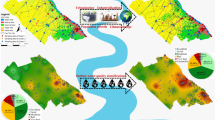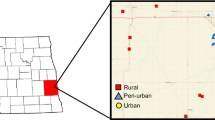Abstract
Water quality degradation is often a severe consequence of rapid economic expansion in developing countries. Methods to assess spatial-temporal patterns and trends in water quality are essential for guiding adaptive management efforts aimed at water quality remediation. Temporal and spatial patterns of surface water quality were investigated for 54 monitoring sites in the Wen-Rui Tang River watershed of eastern China to identify such patterns in water quality occurring across a rural-suburban-urban interface. Twenty physical and chemical water quality parameters were analyzed in surface waters collected once every 4–8 weeks from 2000 to 2010. Temporal and spatial variations among water quality parameters were assessed between seasons (wet/dry) and among major land use zones (urban/suburban/rural). Factor analysis was used to identify parameters that were important in assessing seasonal and spatial variations in water quality. Results revealed that parameters related to organic pollutants (dissolved oxygen (DO), chemical oxygen demand (manganese) (CODMn), and 5-day biochemical oxygen demand (BOD5)), nutrients (ammonia nitrogen (NH4 +-N), total nitrogen (TN), total phosphorus (TP)), and salt concentration (electrical conductivity (EC)) were the most important parameters contributing to water quality variation. Collectively, they explained 70.9 % of the total variance. A trend study using the seasonal Kendall test revealed reductions in CODMn, BOD5, NH4 +-N, petrol, V-phen, and EC concentrations over the 11-year study period. Cluster analysis was employed to evaluate variation among 14 sampling sites representative of dominant land use categories and indicated three, three, and four clusters based on organic, nutrient, and salt water quality characteristics, respectively. Factors that are typically responsible for water quality degradation (including population, topography, and land use) showed no strong correlation with water quality trends implying considerable point source inputs in the watershed. The results of this study help inform ongoing water quality remediation efforts by documenting trends in water quality across various land use zones.





Similar content being viewed by others
References
Alberto WD, del Pilar DA M, Maria Valeria A, Fabiana PS, Cecilia HA, Maria de los Ángeles B (2001) Pattern recognition techniques for the evaluation of spatial and temporal variations in water quality. A case study: Suquia River Basin (Córdoba–Argentina). Water Res 35(12):2881–2894
Baker A (2003) Land use and water quality. Hydrol Process 17(12):2499–2501
Bengraı̈ne K, Marhaba TF (2003) Using principal component analysis to monitor spatial and temporal changes in water quality. J Hazard Mater 100(1–3):179–195
Boyle TP, Fraleigh HD Jr (2003) Natural and anthropogenic factors affecting the structure of the benthic macroinvertebrate community in an effluent-dominated reach of the Santa Cruz River, AZ. Ecol Indic 3(2):93–117
Bu H, Tan X, Li S, Zhang Q (2010) Temporal and spatial variations of water quality in the Jinshui River of the South Qinling Mts., China. Ecotoxicol Environ Saf 73(5):907–913
Chang H (2007) Comparative streamflow characteristics in urbanizing basins in the Portland Metropolitan Area, Oregon, USA. Hydrol Process 21(2):211–222
Chang H (2008) Spatial analysis of water quality trends in the Han River basin, South Korea. Water Res 42(13):3285–3304
Claessens L, Hopkinson C, Rastetter E, Vallino J (2006) Effect of historical changes in land use and climate on the water budget of an urbanizing watershed. Water Resour Res 42(3), W03426
Donohue I, McGarrigle ML, Mills P (2006) Linking catchment characteristics and water chemistry with the ecological status of Irish rivers. Water Res 40(1):91–98
Franczyk J, Chang H (2009) Spatial analysis of water use in Oregon, USA, 1985–2005. Water Resour Manag 23(4):755–774
Hamed KH (2009) Exact distribution of the Mann–Kendall trend test statistic for persistent data. J Hydrol 365(1–2):86–94
Jones RC, Clark CC (1987) Impact of watershed urbanization on stream insect communities. Water Resour Bull 23(6):1047–1055
Kang J-H, Lee SW, Cho KH, Ki SJ, Cha SM, Kim JH (2010) Linking land-use type and stream water quality using spatial data of fecal indicator bacteria and heavy metals in the Yeongsan River basin. Water Res 44(14):4143–4157
Kaufman L, Rousseeuw PJ (2009) Finding groups in data: an introduction to cluster analysis. Wiley, Hoboken, New Jersey, USA
Kazi TG, Arain MB, Jamali MK, Jalbani N, Afridi HI, Sarfraz RA, Baig JA, Shah AQ (2009) Assessment of water quality of polluted lake using multivariate statistical techniques: a case study. Ecotoxicol Environ Saf 72(2):301–309
Li S, Gu S, Tan X, Zhang Q (2009a) Water quality in the upper Han River basin, China: the impacts of land use/land cover in riparian buffer zone. J Hazard Mater 165(1–3):317–324
Li S, Liu W, Gu S, Cheng X, Xu Z, Zhang Q (2009b) Spatio-temporal dynamics of nutrients in the upper Han River basin, China. J Hazard Mater 162(2–3):1340–1346
Li J, Liu H, Li Y, Mei K, Dahlgren R, Zhang M (2013) Monitoring and modeling dissolved oxygen dynamics through continuous longitudinal sampling: a case study in Wen-Rui Tang River, Wenzhou, China. Hydrol Process 27(24):3502–3510
Lu P, Mei K, Zhang Y, Liao L, Long B, Dahlgren R, Zhang M (2011) Spatial and temporal variations of nitrogen pollution in Wen-Rui Tang River watershed, Zhejiang, China. Environ Monit Assess 180(1–4):501–520
O’Sullivan D, Unwin D (2003) Geographic information analysis. Wiley, London, UK
Ouyang Y, Nkedi-Kizza P, Wu QT, Shinde D, Huang CH (2006) Assessment of seasonal variations in surface water quality. Water Res 40(20):3800–3810
Shields FD Jr (2009) Do we know enough about controlling sediment to mitigate damage to stream ecosystems? Ecol Eng 35(12):1727–1733
Shrestha S, Kazama F (2007) Assessment of surface water quality using multivariate statistical techniques: a case study of the Fuji River basin, Japan. Environ Model Softw 22(4):464–475
Singh KP, Malik A, Sinha S (2005) Water quality assessment and apportionment of pollution sources of Gomti River (India) using multivariate statistical techniques—a case study. Anal Chim Acta 538(1–2):355–374
State Environment Protection Bureau of China (2002a) Water and wastewater analysis method. China Environmental Science Press, Beijing (in Chinese)
State Environment Protection Bureau of China (2002b) Environmental quality standards for surface water. China Environmental Science Press, Beijing (in Chinese)
Tang W, Shan B, Zhang H, Mao Z (2010) Heavy metal sources and associated risk in response to agricultural intensification in the estuarine sediments of Chaohu Lake Valley, East China. J Hazard Mater 176 (1–3):945–951
Wang L, Wang Y, Xu C, An Z, Wang S (2011) Analysis and evaluation of the source of heavy metals in water of the River Changjiang. Environ Monit Assess 173(1–4):301–313
Yang L, Mei K, Liu X, Wu L, Zhang M, Xu J, Wang F (2013) Spatial distribution and source apportionment of water pollution in different administrative zones of Wen-Rui-Tang (WRT) river watershed, China. Environ Sci Pollut Res 20(8):1–12
Zhou F, Huang GH, Guo H, Zhang W, Hao Z (2007) Spatio-temporal patterns and source apportionment of coastal water pollution in eastern Hong Kong. Water Res 41(15):3429–3439
Acknowledgments
This research was supported by the Science and Technology Department of Zhejiang Province (2008C03009), Wenzhou City (20082780125), and the Science and Technology Bureau of Wenzhou City (H20100006 and H20100052). The authors would like to express appreciation to the Wenzhou government departments for the data they provided.
Author information
Authors and Affiliations
Corresponding author
Additional information
Responsible editor: Philippe Garrigues
Rights and permissions
About this article
Cite this article
Mei, K., Liao, L., Zhu, Y. et al. Evaluation of spatial-temporal variations and trends in surface water quality across a rural-suburban-urban interface. Environ Sci Pollut Res 21, 8036–8051 (2014). https://doi.org/10.1007/s11356-014-2716-z
Received:
Accepted:
Published:
Issue Date:
DOI: https://doi.org/10.1007/s11356-014-2716-z




